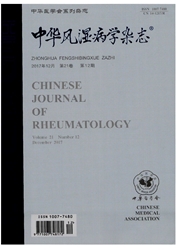

 中文摘要:
中文摘要:
目的 探讨类风湿关节炎(RA)T淋巴细胞上淋巴细胞激活诱导的受体4—1BB的表达及其作用机制。方法 应用流式细胞术检测30例RA患者和20名正常对照者外周血T细胞活化前后4-1BB的表达。结果RA患者CD4^+T和CDS^+T细胞表达的4—1BB明显高于正常对照组[表达百分率分别为(18.56±4.08)%,(10.33±2.13)%,(1.24±0.12)%,(0.87±0.09)%,P<0.01],经抗CD3单抗体外刺激后CD4^+T和CD8^+T细胞表达的4—1BB均显著高于活化前[表达百分率为(33±4)%和(21±8)%,P<0.01]。RA患者CD4^+T/CD8^+T比值明显升高,而且与4-1BB^+CD4^+T细胞数呈正相关关系(r=84,P<0.01),另外4-1BB^+CD4^+T细胞数与血沉、IgA呈正相关关系(r=0.476,P<0.05;r=0.659,P<0.05)。结论 RA患者T细胞表达的4-1BB在RA的发生发展中具有重要意义.4-1BB可能通过对CD4^+T活化与增殖参与关节炎症和免疫反应。
 英文摘要:
英文摘要:
Objective To investigate the exprdssion and role of costimulatory molecule 4-1BB on T cells of patients with rheumatoid arthritis (RA). Metheds The expression of 4-1BB on T lymphocytes from 30 RA patients and20 healthy controls were,detected by flow cytometry. Results The expression of 4-1BB on CD4^+T and CDS^+T lymphocytees from RA patients was significantly higher than that of normal control ( 18.56±4.08,10.33±13 vs 1.24±0.12, 0.87±0.09, P〈0.01). There was more expression of 4-1BB on CD4^+T and CD8^+T lymphocytes stimulated lay anti-CD3 antibody from RA patients (33±4 vs 21±8, P〈0.01). In addition, the ratio of CD4^+T/CD8^+T in RA patients was higher than that of normal controls and was positively correlated with 4-1BB^+CD4^+T cell. The expression of 4-1BB on CD4^+T in RA patients was positively correlated with the level of ESR and IgA (r=0.476, P〈0.05; r=0.659, P〈0.05). Conclusion The costimulatory molecule 4-1BB is abnormally expressed in T lymphocytes from patients with rheumatoid arthritis. The abnormal expression of 4-1BB on T lymphocytes may play an important role in the development of RA. The expression of 4-1BB on CD4^+T cell may take part in the inflammation of RA.
 同期刊论文项目
同期刊论文项目
 同项目期刊论文
同项目期刊论文
 期刊信息
期刊信息
